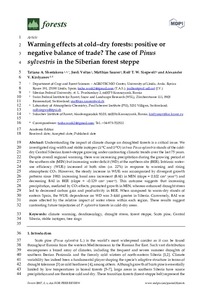Warming Effects on Pinus sylvestris in the Cold–Dry Siberian Forest–Steppe: Positive or Negative Balance of Trade?
Скачать файл:
DOI:
10.3390/f8120490URI (для ссылок/цитирований):
http://www.mdpi.com/1999-4907/8/12/490https://elib.sfu-kras.ru/handle/2311/110802
Автор:
Tatiana A. Shestakova
Jordi, Voltas
Matthias, Saurer
Rolf T. W. Siegwolf
Alexander V. Kirdyanov
Коллективный автор:
Институт экологии и географии
Лаборатория биогеохимии экосистем
Дата:
2017-12Журнал:
ForestsКвартиль журнала в Scopus:
Q1Квартиль журнала в Web of Science:
Q2Библиографическое описание:
Tatiana A. Shestakova. Warming Effects on Pinus sylvestris in the Cold–Dry Siberian Forest–Steppe: Positive or Negative Balance of Trade? [Текст] / Tatiana A. Shestakova, Voltas Jordi, Saurer Matthias, Rolf T. W. Siegwolf, Alexander V. Kirdyanov // Forests. — 2017. — Т. 8 (№ 12). — С. 1-21Аннотация:
Understanding climate change impacts on drought-prone forests is a critical issue. We investigated ring-width and stable isotopes (d13C and d18O) in two Pinus sylvestris stands of the cold–dry Siberian forest–steppe growing under contrasting climatic trends over the last 75 years. Despite regional warming, there was increasing precipitation during the growing period at the southern site (MIN) but increasing water deficit (WD) at the northern site (BER). Intrinsic water use efficiency (WUEi) increased similarly (ca. 22%) in response to warming and rising atmospheric CO2. However, the steady increase in WUEi was accompanied by divergent growth patterns since 1980: increasing basal area increment (BAI) in MIN (slope = 0.102 cm2/year2) and decreasing BAI in BER (slope = -0.129 cm2/year2). This suggests that increased precipitation, mediated by CO2 effects, promoted growth in MIN, whereas intensified drought stress led to decreased carbon gain and productivity in BER. When compared to warm–dry stands of eastern Spain, the WUEi dependence on WD was three-fold greater in Siberia. Conversely, BAI was more affected by the relative impact of water stress within each region. These results indicate contrasting future trajectories of P. sylvestris forests, which challenge forecasting growth and carbon sequestration in cold–dry areas.

